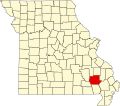History
A post office called Silva has been in operation since 1902. [3] An early postmaster gave the community the name of one of her acquaintances. [4]
Silva is home to Camp Lewallen, a Boy Scout Camp serving the Scouts of the Greater St. Louis Area Council. [5] It has a replica statue of the Strengthen the Arm of Liberty. [6]
Silva was struck by three tornadoes. The first one struck the town on May 21, 1957, hitting four farms, damaging other structures, and unroofing a few houses. [7] The second one struck on May 25, 2011. A camper, a mobile home, and several vehicles were destroyed, churches were damaged, and many roads were blocked by fallen trees. Two people were injured by one of those fallen trees. [8] In the 2011 Super Outbreak, it was also struck by an F1 tornado, which damaged the side of a church and downed several trees. [9]
This page is based on this
Wikipedia article Text is available under the
CC BY-SA 4.0 license; additional terms may apply.
Images, videos and audio are available under their respective licenses.

